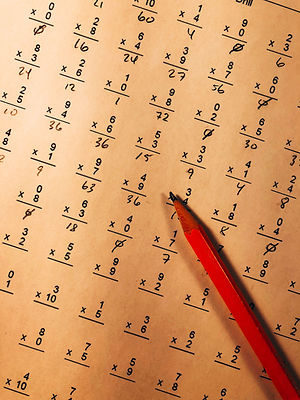
MathBait™ Multiplication
Bone Maze
Share this resource!
Can you determine the secret code using your knowledge of multiples? In this activity, teachers provide students with a string of numbers and a path through Napier's Bones. Players must use their problem solving and multiplication knowledge to determine the order of the rods.
Details
Resource Type
Activity
Primary Topic
Playing with Napier's Bones
Unit
6
Activity
4
of
10
This activity is great for students learning to multiply or practicing fluency.
To set up this activity, teachers will need to build a maze. Using our Digital Bones (see MathBait™ Multiplication Part 5), this can be done quickly and easily. Take a set of 8-10 bones and place them in any order you would like. Next, highlight a path from a value on the first bone to a value on the last bone. Finally, write down the series of digits you have crossed. For younger students, include spaces to help with processing. For older students, smash the numbers together, making it more difficult to identify where one begins and ends.
You may wish to provide students with a grid or blank bones. You can find a printable version in MathBait™ Multiplication Part 5.
To play, students follow the path, placing the numbers in the code as they go. To escape the maze, they must provide the exit code which is the order of the bones in the maze.

The basis of this activity is simply to recognize multiples. If we know the maze begins in the 6th row and the value is 18, we need only to determine what number times 6 equals 18 to quickly find the first bone must be a 3. This makes this activity great for students building fluency. Students may also consider common multiples.
Make the game less challenging by adding more movement, such as going up a few values on a rod. This will provide students with more multiples to work with and recognize.
To add more challenge to the game, show the shape of the path off the bone chart. This requires more problem solving to determine how these values could fit together. For a super challenge, only provide students with a few of the numbers without telling them where in the path they fall. This allows students to consider their multiples to determine, for instance, if 18 is on the path (somewhere) it must be in the 2nd, 3rd, 6th, or 9th rows. This can be an excellent introduction to factoring. To provide students with additional support, allow them to use their completed rods as they problem solve.
The material on this page is copyrighted by MathBait™. Please use and enjoy it! MathBait™ provides a temporary license for Non-Commercial purposes. You are not permitted to copy, distribute, sell, or make derivative work without written permission from MathBait™.
Tell us what you think!
Click to rate this activity

